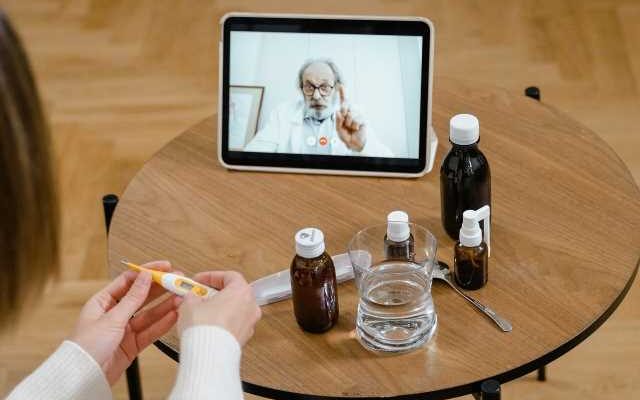
Historically, there has been racial inequity when it comes to primary care appointments, which are vital for managing and preventing chronic disease. But as COVID-19 struck the United States in 2020 and telemedicine availability rose sharply, gaps in access disappeared for Black patients at Penn Medicine, new research shows. And even once “normal” in-office appointments returned, the historic inequities stayed erased, indicating that telemedicine wasn’t just a stopgap solution but a potential long-term tool for equity. These findings, from researchers at the Perelman School of Medicine at the University of Pennsylvania, were published in Telemedicine and e-Health.
“We looked through the entire year of 2020, not just the first half of the year when telemedicine was the only option for many people, and the appointment completion gap between Black and non-Black patients closed,” said the study’s senior author, Krisda Chaiyachati, MD, an assistant professor Medicine at Penn Medicine and the physician lead for Value-based Care and Innovation at Verily. “Offering telemedicine, even though it was for a crisis, appears to have been a significant step forward toward addressing long-standing inequities in healthcare access.”
COVID-19’s sudden onset in early 2020 resulted in a telemedicine boom. Use of telemedicine had typically been narrow, largely as a result of regulations and hesitancy among payers, but emergency provisions allowed health care entities to quickly conduct appointments via phone or computer. There was some concern that these developments, while good for preventing the spread of COVID, might adversely impact racial and ethnic groups who have been historically underserved by health care.
That’s why Chaiyachati—who headed Penn Medicine’s virtual visit service, Penn Medicine OnDemand, through most of the pandemic—and his fellow researchers decided to focus on whether Black patients at Philadelphia-area practices were able to see their primary care providers as often in 2020 as they had in 2019, and then compare those numbers to non-Black patients (which in this population mainly consists of white, non-Hispanic people). Data from roughly 1 million appointments in each year were analyzed.
Findings from this analysis showed that completed primary care visits rose from approximately 60 percent among Black patients before the arrival of COVID-19 to over 80 percent in 2020. To compare, non-Black patients’ visit completion rate was in the 70 percent range prior to COVID-19, then was also over 80 percent in 2020. The equity gap of at least 10 percent disappeared at Penn Medicine practices after the pandemic arrived, when telemedicine was widely adopted.
“The specific time periods where we saw significant gains made by Black patients came when telemedicine was well-established in our health system,” Chaiyachati said. “This does not appear to be a coincidence.”
Overall, raw totals indicated that completed primary care visits declined in 2020 compared to 2019, which wasn’t unexpected due to infection control-related shutdowns and general hesitancy among the public to be seen in person. It also was not unexpected that the numbers of completed appointments via telemedicine would rise in 2020 compared to the year before. This happened exponentially: In 2019, among the million total visits studied, completed telemedicine appointments were in just the double digits. In 2020, these telemedicine appointments were in the six-figure range.
Data also showed that proportionately, Black patients took part in telemedicine much more often than non-Black patients. Roughly 33 percent of Black patients’ 2020 appointments were completed via telemedicine, with 25 percent occurring via telemedicine for non-Black patients. Rates for both were below a tenth of a percent the year before.
But the researchers sought to get a closer look at how visits trended over 2020, so they split the years they studied up into four distinct time periods based on 2020’s events: Pre-pandemic (January until March 12, largely before COVID-19 struck the Philadelphia area); Shutdown (March 13 until June 3, when stay-at-home orders were largely in place); Re-opening (June 4 through September, when stay-at-home orders were mostly lifted); and Second Wave (October through December, when COVID-19 cases began to surge again).
The Shutdown period showed the starkest changes compared to 2019. Completed visits dropped for Black patients during that period in 2020 by roughly 8 percent, but non-Black patients’ visit completion rates fell precipitously, by 20 percent. After that, non-Black rates returned to their regular 2019 averages, while Black patients’ rates climbed dramatically (to 7 and 8 percent above their 2019 levels) in the two time periods following. The argument could be made that more people sought medical attention in 2020 due to COVID-19’s presence. But analyses showed that while visits during the Shutdown period were largely tied to concerns about COVID-19, the visits in the latter half of 2020 involved concerns that closely resembled visits in 2019.
“Telemedicine allowed patients to seek non-urgent primary care despite hesitancy for in-person visits pre-vaccine,” said study co-author Corinne Rhodes, MD, an assistant professor of Internal Medicine and assistant medical director of Quality in Penn Medicine’s Primary Care Service Line. “Providing chronic disease management and preventive care helped return primary care offices closer to pre-pandemic business as usual.”
While there was some concern at the start of the pandemic that introducing telemedicine might deepen access problems, this study adds to evidence that that may not be the case, at least for primary care.
Source: Read Full Article
